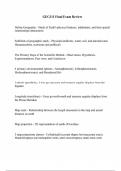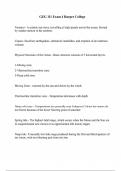GEG 111 (GEG111)
Harper College
All 20 results
Sort by

-
Exam 1 GEG 111
- Exam (elaborations) • 7 pages • 2024
-
Available in package deal
-
- $11.00
- + learn more
What is geography? The science that studies the relationship among processes that occur naturally, geographic areas, environment, etc. Subfields of Geography Physical and human geography Steps of the Scientific Method Identify problem, Form Hypothesis, Collect Data, Analyze Data, Form Conclusions Difference between hypothesis and theory In science, a theory is a tested, well-substantiated, unifying explanation for a set of verified, proven factors. A theory is always backed by evidence...
![[GEG 111] Exam 1](/docpics/6379159/6708ced6e150e_6379159_121_171.jpeg)
-
[GEG 111] Exam 1
- Exam (elaborations) • 5 pages • 2024
-
Available in package deal
-
- $10.00
- + learn more
The graph and image below show. a temperature inversion Sources of natural variable pollutants and materials include all of the following EXCEPT industrial activity ENSO (El Niño - Southern Oscillation) episodes are marked by Warmer than normal sea surface temperatures along the western South American coast. A stove that circulates heated air to uniformly cook food is an example of ________ heat transfer. convectional Which of the following has the highest albedo? Fresh snow on a mo...

-
GEG 111 Exam 3 Study Guide
- Exam (elaborations) • 5 pages • 2024
-
Available in package deal
-
- $8.00
- + learn more
Longest. In geologic time: - Eon Study of the origin, evolution,form, and spatial distribution of earths landforms: - Geomorphology Uppermost layer of earth: - Crust layer of earth between the crust and the core: - mantle Innermost layer of earth: - Core The crust and upper most part of the mantle refers to what sphere? - Lithosphere Beneath the lithosphere is a plastic layer known as the, - Asthenosphere A mineral must be: - Inorganic, definite chemical composition, solid. Land that ri...

-
GEG 111 Harper Exam Two
- Exam (elaborations) • 13 pages • 2024
-
Available in package deal
-
- $12.00
- + learn more
Properties of water - • Exists as a liquid at most places on Earth's surface • Expands when it freezes; which is important in the weathering of rock • Hydrogen bonding creates surface tension, a "skin" of molecules giving water a stickiness quality - surface tension • Capillarity; water can "climb" up narrow openings. This is important to the movement of groundwater. • Good solvent; water dissolves most substances • High specific heat; it takes a relatively hi...

-
GEG 111 Final Exam (Harper College)
- Exam (elaborations) • 19 pages • 2024
-
Available in package deal
-
- $11.00
- + learn more
Physical Geography - Looks at the natural processes of the Earth, such as climate and plate tectonics. Human Geography - Looks at the impact and behaviour of people and how they relate to the physical world. Scientific Method - The Scientific Method looks to establish ideas, but also willing to modify, reject of change them when new evidence is found. The Scientific Method: 1. Observe 2. Form a question 3. Create Hypothesis 4. Test Hypothesis 5. Collect Data 6. Draw Conclusion The F...

-
GEG111 Final Exam Review
- Exam (elaborations) • 18 pages • 2024
-
Available in package deal
-
- $12.00
- + learn more
Define Geography - Study of Earth's physical features, inhabitants, and their spatial relationships/interactions Subfields of geographic study - Physical(landforms, water, soil, and animals) and Human(culture, economic and political) The Primary Steps of the Scientific Method - Observation, Hypothesis, Experimentation, Peer view, and Conclusion 4 primary environmental spheres - Atmosphere(air), Lithosphere(stone), Hydrosphere(water), and Biosphere(life) Latitude (parallels) - Lines go...

-
GEG 111 - Exam 2 Geography - Chapters 9-17
- Exam (elaborations) • 73 pages • 2024
-
Available in package deal
-
- $13.00
- + learn more
Which of the following is an exogenic process? Volcanism Weathering Earthquakes Flows of heat and materials in the mantle - Weathering Which of the following is an endogenic process? Weathering Glacial erosion Volcanism Stream deposition - Volcanism Uniformitarianism assumes that mountains, plains, and canyons formed by catastrophic events. catastrophic episodes have regularly occurred. Earth is quite young and is shaped by dramatic events. the same physical processes we see today ...

-
GEG 111 Exam 3
- Exam (elaborations) • 12 pages • 2024
-
Available in package deal
-
- $11.00
- + learn more
Which of the following is an exogenic process? - weathering Which of the following is an endogenic process? - volcanism Uniformitarianism assumes that - the same physical processes we see today are a key to understanding the processes that have been operating throughout geologic time Which of the following is CORRECT regarding the geologic time scale? - The bulk of Earth's history has occurred during the Precambrian eon. Which of the following is NOT a criteria to be classified as a mi...

-
GEG 111 Exam 4 Chapters 13 - 17
- Exam (elaborations) • 13 pages • 2024
-
Available in package deal
-
- $11.00
- + learn more
Within the deep cold zone, average temperature and salinity - remain fairly constant with depth. When the height of a wave exceeds its vertical stability, the wave is called a - breaker. Which of the following is CORRECT regarding mean sea level? - It is calculated based on average tidal levels recorded hourly at a given site over a period of many years. The height of a tsunami grows as it approaches a coastline primarily because - its wavelength shortens. When the Sun and Moon are neit...

-
GEG 111 Exam 4 Harper College
- Exam (elaborations) • 7 pages • 2024
-
Available in package deal
-
- $8.00
- + learn more
Tsunami - A seismic sea wave, travelling at high speeds across the ocean, formed by sudden motion in the seafloor. Causes: Sea-floor earthquakes, submarine landslides, and eruption of an undersea volcano Physical Structure of the Ocean - Basic structure consists of 3 horizontal layers: 1-Mixing zone 2-Thermocline transition zone 3-Deep cold zone Mixing Zone - warmed by the sun and driven by the winds Thermocline transition zone - Temperature decreases with depth Deep cold zone - Temper...

Did you know that on average a seller on Stuvia earns $82 per month selling study resources? Hmm, hint, hint. Discover all about earning on Stuvia


